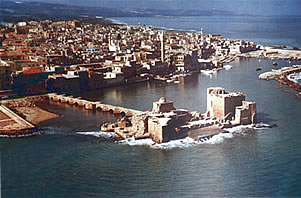Sidon
 |
SIDON - About midway between Beirut and Tyre, on the edge of a fertile strip of plain stretching from the mountain to the shore, a small rocky promontory juts into the sea. Here stood the ancient city of Sidon. The site was chosen doubtless because of the excellent harbour formed by a series of small islets, a short distance from the shore, which protected shipping lying by the city. In old times the islets were joined together by artificial embankments. This harbour lay to the N.; on the S. was a second one, larger but less secure, known as the Egyptian harbour. Sidonians is sometimes used for Phoenicians in the OT (Gn.10.15, Jg.10.12 etc.) as regularly in Homer. Sometimes Sidon is called 'Great Sidon' (Jos.11.8 etc.). The Sidonians excelled in artistic metal work (cf Homer, Il, xxiii. 743-748) and in the products of the loom, the value of which was enhanced by the famous dye, used first by the Sidonians, but known to the later world as 'Tyrian purple.' The planting of colonies was a natural, and almost necessary, outcome of her commercial enterprise. Aradus (Strabo, xvi. ii. 13) and Carthage (Appian, de Rebus Punicis, 1, etc.) are said to have been founded by her, and she seems to claim on a coin to be the mother-city of Melita or Malta, as well as of Citium and Berytus. King Zimrida of Sidon appears in the Amarna tablets as rebel against Egyptian rule. Sidonian ascendancy succeeded the decline of the Egyptian power after Rameses II. How long it lasted we do not know. The Asherites, who had not dispossessed the Sidonians (Jg.1.31), allegedly suffered oppression at their hands (10.12). By the time of Solomon, however, Tyre had assumed the hegemony (Jos. Ant. viii. v. 3 [141 ft], c. Apion, i. 18 [116 if]). But Assyrian power was now expanding and Tiglath-pileser I. c 1100 BC had already assumed the heritage of the Hittites by coming to Arvad. In 877 BC Sidon, with other Phoenician cities, submitted to Ashur-nasir-pal and 'sent him presents.' Sidon suffered under Shalmaneser III., Tiglath-pileser III., Shalmaneser v., and finally was subdued by Sennacherib, who made Tubaal, a creature of his own, king. A revolt under Tubaal's successor led to the utter destruction of the city in 678 BC by Esarhaddon, who built a new city called by his own name. The attempt to gain Judah for the league against the growing power of Babylon brought an embassy to Jerusalem, in which the king of Sidon was represented (Jer.27.3). A revolt joined in by Judah, was stamped out by Nebuchadrezzar in 597 BC. Sidon's swift submission was due to devastating pestilence (Ezk.28.21ff). The long resistance of Tyre led to her destruction and humiliation (Ezk.26.8ff), Sidon once more assuming the leadership.
In the beginning of the Persian period the Phoenician cities enjoyed practical autonomy, and a time of great material prosperity. A friendly arrangement with Cambyses perpetuated this state of things, and in the Greek wars most valuable assistance was given by the Phoenicians to the Persians. The revolt of the Phoenicians, headed by Sidon, about 351 BC, was remorselessly crushed by Artaxerxes Ochus. Sidon was betrayed into his hands by the despairing king, Tennes. The inhabitants burned the city, more than 40,000 perishing in the flames. Perhaps at this time Sidonians were settled at Shechem, where Alexander encountered a population claiming that name (Jos. Ant. xi. viii. 6 [344]). But the city rose again from its ashes, and regained something of its former prosperity. The son of Tennes became king and retained the sceptre till the advent of Alexander.
While Phoenicia then lost her predominance in the trade of the Mediterranean, Sidon retained considerable importance as the possessor of an excellent harbour, and as a seat of Phoenician industry. Lying in the territory often in dispute between Syria and Egypt, in the following centuries Sidon several times changed hands. Under the Romans she enjoyed the privileges of a free city. Sidon figures in the Gospel narratives (Mt.11.21f, 15.21, Mk.3.8 etc.). Jesus may have passed through territory belonging to the city (Mk.7.31). It appears in Ac.12.20, and was touched at by St. Paul in his voyage to Rome (Ac.27.3). It later became the seat of a bishop. Sidon suffered heavily during the Crusades. Under the Druse prince, Fakhreddin (1595-1634), its prosperity revived; but, in order to prevent the approach of the Turkish fleet, he caused the entrance to the harbour to be filled up, thus making it comparatively useless. The present walls of the city were built by Mohammed 'Ali of Egypt (1832-1840). The fortress, Kal 'at el-Bahr, 'Castle of the Sea,' dating from the 13th cent., stands on the largest of the islands, which is joined to the mainland by a bridge of 9 arches. The present population is about 11,000. The chief occupations are fishing, and the cultivation of the gardens and orange groves for which modern Sidon is famous. While the oldest existing building dates from the Middle Ages, there are many remains of great antiquity, traces of walls, hewn stones, pillars, coins, and the reservoirs cut out of the rock. The most important discoveries so far have been (1855) the sarcophagus of king Eshmunazar (early in the 4th cent. BC), with the well-known inscription, now in Paris; and (1887) the tomb containing 17 Phoenician and Greek sarcophagi, highly ornamented; among them that of Tabnit, father of Eshmunazar, and the so-called Alexander Sarcophagus - probably that of Abdalonimus, whom Alexander restored to the throne of his fathers. [Article: Dictionary of the Bible, J.Hastings, 2nd Ed., T&T.Clark, 1963 - W.E. - E.G.K.]